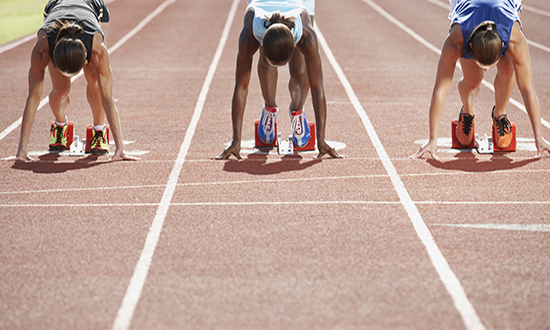In 1996, the Women’s Sports Foundation paired with Evian Natural Spring Water to closely investigate the comparative earnings, exclusive of endorsements, of male and female professional athletes in the first Women’s Sports Foundation/Evian Athletes’ Earnings Gap Index.
In the past 30 years, Title IX has afforded millions of girls the opportunity to participate in athletics. In 1972, 1 in 28 girls participated in high school athletics. The idea of a college scholarship to continue playing sports was unheard of, and the possibility of having a professional career was perhaps only dreamed about. Today, 1 in 2.5 girls participate in high school athletics, $180 million is awarded to female athletes to play at the collegiate level, and there are a variety of established professional women’s leagues. Girls and women can now more than dream of making a career of playing sports. During the 30th anniversary year of Title IX, the Women’s Sports Foundation celebrates the achievements of countless female athletes but also examines the inequalities that remain.
In 1996, the Women’s Sports Foundation paired with Evian Natural Spring Water to closely investigate the comparative earnings, exclusive of endorsements, of male and female professional athletes in the first Women’s Sports Foundation/Evian Athletes’ Earnings Gap Index. The chief finding was that significant inequality exists in prize money available to male and female athletes across many sports (See Tables 1 and 2).
In the first study, we compared the total prize purses available to men and women as well as the average earnings of the top 10 male and female athletes in five sports – beach volleyball, bowling, downhill skiing, golf and tennis. The average prize earnings of the top 10 male athletes were double that of females in tennis, meaning that for every $1.00 a man earned, a woman earned $.49 (1:.49), followed by bowling (1:.46), skiing (1:.30), and beach volleyball (1:.20) (See Figure 1). The study also found that the 1995-1996 average salary of male NBA players, $1.7 million, was 24 times greater than the average salary of female players, $70,000 in the newly formed American Basketball League (1996-1997 season).
The second study, conducted from 1996-2000, revealed continuing inequities but significant declines in the earnings gaps in tennis, bowling, golf and skiing. Over the five-year period, the average prize earnings of the top 10 male and female athletes were closest in bowling (1:.70), followed by tennis (1:.67), and golf (1:36). The 1999-2000 average NBA salary rose to $3.17 million per player, while the average WNBA salary for the same season was $55,000, making the NBA average 58 times higher than the WNBA. Beach volleyball was not repeated in the 1996-2000 study because both the men’s and women’s tours experienced interruptions in play and prize money during that period. For basketball, only the average salaries for all players were available.
Tracking the total purses, average salaries and total earnings of athletes is essential in the analysis of equality. As women’s professional leagues grow in both sponsorship and interest, the Women’s Sports Foundation will continue to monitor the data, educate the media and public, and work with professional leagues to increase sponsorship and fan development. What can you do as a fan? You can help us help them. Become a member of the Women’s Sports Foundation. Write a letter to thank a sponsor of one of the many women’s professional leagues. Take your family to women’s professional games or buy season tickets to your favorite teams. Write a letter to Congress through our new Web content area, www.GeenaTakesAim.com, and tell them how important it is to support women’s athletics. Learn about the history of Title IX, about how far women have come and how far women still have to go. For complete results of both studies, please visit the Foundation’s Web site at www.WomensSportsFoundation.org or AOL Keyword: WSF.
Jennifer Arndt was the Education Intern at the Women’s Sports Foundation in Fall 2001. This article first appeared in the Spring 2002 issue of the Women’s Sports Experience. Data for the 1996-2000 study was collected and complied by Helene Sisti, Temple University doctoral student and former Foundation intern.


